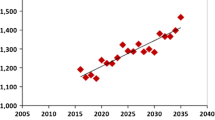Abstract
By 2050, and in the context of decarbonization and carbon neutrality, many companies worldwide are looking for low-carbon alternatives. Transport companies are probably the most challenging due to the continuing growth in global demand and the high dependency on fossil fuels. Some alternatives are emerging to replace conventional diesel vehicles and thus reduce greenhouse gas emissions and air pollutants. One of these alternatives is the adoption of compressed natural gas (CNG). In this paper, we provide a detailed study of the current emissions from the largest bus fleet company in the metropolitan area of Oporto. For this analysis, we used a top-down and a bottom-up methodology based on EMEP/EEA guidebook to compute the CO2 and air pollution (CO, NMVOC, PM2.5, and NOx) emissions from the fleet. Fuel consumption, energy consumption, vehicle slaughter, electric bus incorporation, and the investments made were taken into consideration in the analyses. From the case study, the overall reduction in CO2 emission was just 6.3%, and the emission factors (air pollutants) from CNG-powered buses and diesel-powered buses are closer and closer. For confirming these results and question the effectiveness of the fleet transitions from diesel to CNG vehicles, we analysed two scenarios. The obtained results reveal the potential and effectiveness of electric buses and other fuel alternatives to reduce CO2 and air pollution.
Access this chapter
Tax calculation will be finalised at checkout
Purchases are for personal use only
Similar content being viewed by others
References
World Health Organization (WHO) Homepage: Air pollution section. https://www.who.int/health-topics/air-pollution#tab=tab_1. Last accessed 2021/12/18
Climate Change 2021 Homepage: The Physical Science Basis. https://www.ipcc.ch/report/ar6/wg1/. Last accessed 2021/12/18
European Union Homepage: European Green Deal Section. https://ec.europa.eu/info/strategy/priorities-2019-2024/european-green-deal_en. Last accessed 2021/12/18
IEA Homepage: Tracking Transport Report. Retrieved from https://www.iea.org/. Last accessed 2021/12/22
Rose, L., Hussain, M., Ahmed, S., Malek, K., Costanzo, R., Kjeang, E.: A comparative life cycle assessment of diesel and compressed natural gas-powered refuse collection vehicles in a Canadian city. Energy Policy 52, 453–461 (2013)
Engerer, H., Horn, M.: Natural gas vehicles: an option for Europe. Energy Policy 38, 1017–1029 (2010)
Plassat, P., Coroller, G.: Comparative study on exhaust emissions from diesel and CNG powered urban buses. In: DEER 2003 Conference. French Agency of Environment and Energy Management (ADEME) Air & Transport Division (2003)
Pulkrabek, W.W.: Engineering Fundamentals of the Internal Combustion Engine. Prentice Hall (1997)
NGV (Natural Gas Vehicle) Database: NGV Global Statistics Homepage. Retrieved from https://www.iangv.org/current-ngv-stats/. Last accessed 2021/12/22
Lowell, D.: Clean Diesel Versus CNG Buses: Cost, Air Quality, and Climate Impacts
Nylund, N.-O., Koponen, K.: Fuel and technology alternatives for buses. VTT Technol. 46 (2012)
Merkisz, J., Fuc, P., Lijewski, P., Pielecha, J.: Actual emissions from urban buses powered with diesel and gas engines. In: TRA (ed.), 6th Transport Research Arena 3070–3078 (2016)
Galbieri, R., Brito, T., Mouette, D., Costa, H., dos Santos, E., Fagá, M.: Bus Fleet Emissions: New Strategies for Mitigation by Adopting Natural Gas. Part of Springer Nature (2017)
Hallquist, A.M., Jerksjo, M., Fallgren, H., Westerlund, J., Sjodin, A.: Particle and gaseous emissions from individual diesel and CNG buses. Atmos. Chem. Phys. Discuss 13, 5337–5350 (2013)
STCP Homepage: Institutional Section. Retrieved from https://www.stcp.pt/pt/institucional/governo-societario/relatorio-e-contas/. Last accessed 2022/01/21
EEA: EMEP/EEA air pollutant emission inventory guidebook. Guidebook from European Monitoring and Evaluation Program (EMEP) and European Environment Agency (EEA) (2019). https://www.eea.europa.eu/
APREN: Boletim Eletricidade Renovável (2019). https://www.apren.pt/contents/publicationsreportcarditems/02-boletim-energias-renovaveis-vf.pdf
Regulation No 582/2011 concerning emissions from heavy-duty vehicles. https://eur-lex.europa.eu/legal-content/EN/TXT/?uri=CELEX%3A02011R0582-20210101
Argonne National Laboratory: An extensive study on sizing, Energy consumption, and cost of advanced vehicle technology (2018). Retrieved from the U.S. Department of Energy website, https://afdc.energy.gov/fuels/electricity_research.html
U.S. Energy Information Administration Homepage. https://www.eia.gov/energyexplained/natural-gas/. Last accessed 2021/12/22
Nanaki, E.A., Koroneos, C.J., Xydis, G.A., Rovas, D.: Comparative environmental assessment of Athens urban buses diesel, CNG and biofuel-powered. Transp. Policy 35, 311–318 (2014)
Ambient air quality and cleaner air for Europe. Directive 2008/50/EC of the European Parliament (2008). https://ec.europa.eu/environment/air/quality/existing_leg.htm
Acknowledgement
This work is financed by National Funds through the FCT – Fundação para a Ciência e a Tecnologia (Portuguese Foundation for Science and Technology) within the project e-LOG (EXPL/ECI-TRA/0679/2021). Tânia Fontes also thanks FCT for the Post-Doctoral scholarship SFRH/BPD/109426/2015.
Author information
Authors and Affiliations
Corresponding author
Editor information
Editors and Affiliations
Rights and permissions
Copyright information
© 2023 The Author(s), under exclusive license to Springer Nature Switzerland AG
About this paper
Cite this paper
Oliveira, J.P.F., Fontes, T., Galvão, T. (2023). The Impact of CNG on Buses Fleet Decarbonization: A Case Study. In: Nathanail, E.G., Gavanas, N., Adamos, G. (eds) Smart Energy for Smart Transport. CSUM 2022. Lecture Notes in Intelligent Transportation and Infrastructure. Springer, Cham. https://doi.org/10.1007/978-3-031-23721-8_50
Download citation
DOI: https://doi.org/10.1007/978-3-031-23721-8_50
Published:
Publisher Name: Springer, Cham
Print ISBN: 978-3-031-23720-1
Online ISBN: 978-3-031-23721-8
eBook Packages: EngineeringEngineering (R0)




